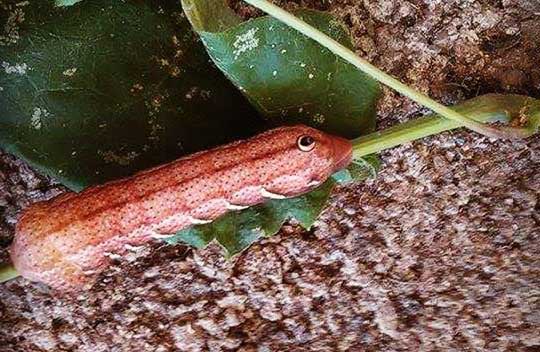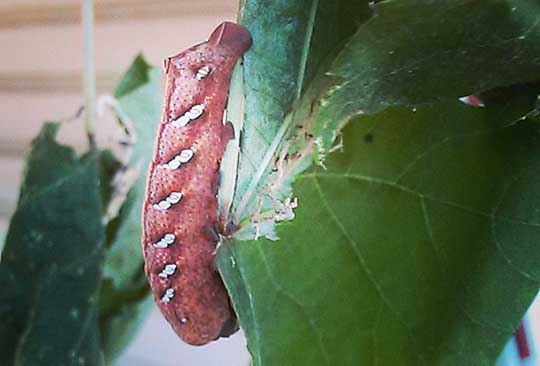Sphinginae subfamily
Sphingini tribe:

|
Manduca quinquemaculatus
BAMONA,
Five-spotted Hawkmoth.
Tomato Hornworms: each has a black horn at the end of the abdomen.
Larvae feed on potato, tobacco, tomato, and other plants in the
nightshade family (Solanaceae). There is also a very beautiful brown form. See bottom of page.
|
 |
Manduca sexta
BAMONA, the Carolina Sphinx
Tobacco Hornworms, equipped with a red-tipped horn at the end of the
abdomen, are true gluttons and feed on tobacco and tomato, and
occasionally potato and pepper crops and other plants in the
nightshade family (Solanaceae).
|
 |
Sphinx chersis BAMONA, Great Ash Sphinx.
Larvae pale bluish green. Head has a pair of yellow
lateral bands meeting at the apex.
Larval hosts are ash, lilac, privet, cherry, and quaking aspen.
|
 |
Larvae hide in day; feed primarily on cherry, plum, apple
at night. Larvae have been found on Amelanchier nantuckensis
in Massachusetts and have been reared to pupation in Michigan on
Prunus serotina. Note purple oblique lines.
|
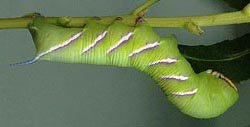 |
Sphinx perelegans
BAMONA, Elegant Sphinx;
A unique feature is a shield on first thoracic
segment, which is of same colour as body and which forms a
tight-fitting hood over the vertex of the head. This hides a pair of
glossy black spots on top of the head, which are revealed if
animal is disturbed.
|
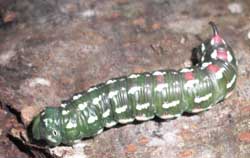 |
Larvae feed on California juniper (Juniperus californica) and Rocky Mountain juniper (J. osteosperma).
|
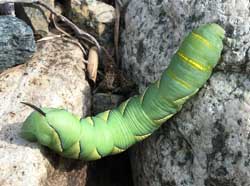 |
Sphinx vashti
BAMONA,
the Snowberry Sphinx
Larvae feed on the common snowberry (Symphoricarpos albus)
and on coralberry (S. orbiculatus). Note the two golden
lines of slightly raised bumps, one just behind the head, the other
on the thorax.
|
Smerinthini Tribe:
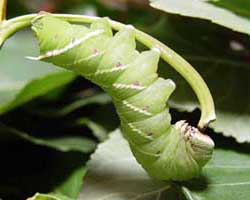 |
Larvae feed on cottonwood and poplar (Populus) and willow
(Salix).
Larvae are very chunky with little to distinguish them
from Pachysphinx modesta.
|
 |
Larvae accept willows, birches, and cherries.
I have also found them in the wild on oak in eastern Canada.
Skin is quite granulous.
|
 |
Paonias myops
BAMONA, the Small-eyed Sphinx
Wild cherry species are the favorites as larval foodplants, but eggs
will also be deposited on birches and other forest trees.
There are varying degrees in the amount of red markings along the sides.
|
 |
Smerinthus cerisyi
BAMONA,
Cerisy's Sphinx;
Greatly resemble modesta larvae, both being pale
green, with granular skin, pale lateral diagonal lines, faint red
spiracular circles, very pale longitudinal lines running from
head to a more pronounced anal diagonal line.
Green heads bounded dorsally with a pale yellow inverted "V".
|
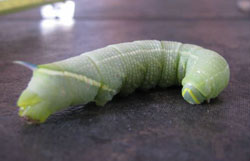 |
Smerinthus ophthalmica
WO (more likely than cerisyi):
Resemble cerisyi larvae, both being pale
green, with granular skin, pale lateral diagonal lines, faint red
spiracular circles, very pale longitudinal lines running from
head to more pronounced anal diagonal line.
Green heads bounded dorsally with pale yellow inverted "V". Note blue horn.
|
Macroglossinae subfamily
Dilophonotini Tribe:
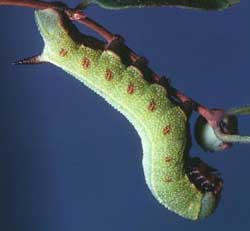 |
Larval host plants include Snowberry (Symphoricarpos),
honeysuckle (Lonicera), Coralberry, viburnums, high bush cranberry and hawthorn (Crataegus).
Horn is black with a slightly lighter base. This western species was formerly classified as
H. diffinis or H. senta. Those species west of the Continental Divide are now classified as
H. thetis.
|
Philampelini Tribe:
 |
Larvae feed upon Grape (Vitis), Virginia Creeper
(Parthenocissus quinquefolia) and other vines and ivies
(Ampelopsis).
Larvae occur in both a light (green) form and a darker (tan/brown)
form. Note six "segmented" oblique lines.
|
Macroglossini Tribe:
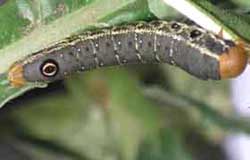 |
Arctonotus lucidus
BAMONA, the Pacific Green
Sphinx Moth or Bear SphinxLarvae feed on evening primrose
(Oenothera dentata var. campestris) and clarkias. David Wikle
fed them on both Mexican evening primrose, Oenothera berlandieri
and evening primrose, Oenothera biennis. |
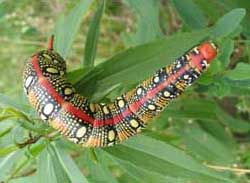 |
Hyles euphorbiae
WO ??, Leafy Spurge Hawk Moth
Larvae feed on leafy spurge. Larvae are also conspicuously colored, with a
pronounced tail or "horn" near rear end.
Young larvae are variously patterned with green, yellow, and black;
older larvae have distinctive red, black, yellow, and white color
pattern. Mature larvae may approach 10 cm in length; when disturbed,
they regurgitate a slimy green liquid.
|
 |
Hyles lineata
BAMONA, the White-lined Sphinx
Larvae are highly varied and feed on a great diversity of plants
including willow weed (Epilobium), four o'clock (Mirabilis),
apple (Malus), evening primrose (Oenothera), elm
(Ulmus), grape (Vitis), tomato (Lycopersicon),
purslane (Portulaca), and Fuschia.
All larvae seem, however, to have the red/black swellings split by
dorso-lateral lines. |
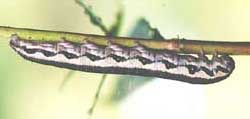 |
Larvae feed on elegant fairyfan (Clarkia unguiculata) in the evening primrose family (Onagraceae). |
|
|
